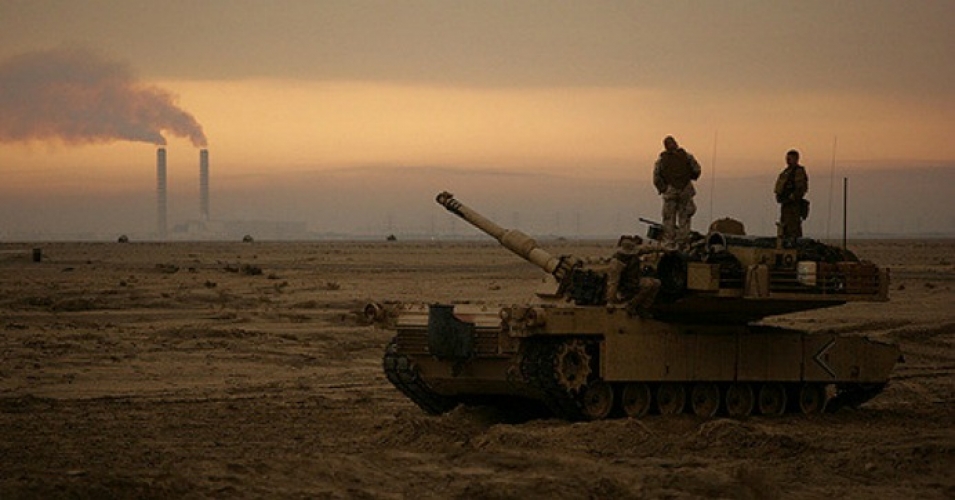Post-9/11 Wars Have Cost Nearly $5 Trillion (and Counting): Report
MILITARISM, 19 Sep 2016
As nation remembers 9/11 victims, report calculates cost of military response to attacks.

The estimate includes budget requests for the 2017 operations in Afghanistan—which are poised to continue even after President Barack Obama vowed to withdraw troops from the country by then. (Photo: Marines/flickr/cc)
13 Sep 2016 – The U.S. military interventions in Iraq and Afghanistan have cost taxpayers nearly $5 trillion and counting, according to a new report released to coincide with the 15th anniversary of the attacks.
Dr. Neta Crawford, professor of political science at Brown University, released the figures in an independent analysis (pdf) of U.S. Departments of Defense, State, Homeland Security, and Veteran Affairs spending, as well as their base and projected future spending. Crawford is also a director at Brown’s Costs of War Project, which works to draw attention to the human, economic, and political toll of the military response to 9/11.
In total, the wars already boast a price tag of $4.79 trillion, she found. And the cost is still climbing.
Crawford’s estimate includes budget requests for the 2017 operations in Afghanistan—which are poised to continue despite President Barack Obama’s vow to withdraw troops from the country by then—as well as in Iraq and Syria. The Pentagon requested $66 billion for those fights just for that year.
However, even if the U.S. stopped spending on war at the end of this fiscal year, the interest costs, such as debt for borrowed funds, would continue to rise. Post-9/11 military spending was financed almost entirely by borrowing, which in turn has driven debt and interest rates, the project has previously noted.
Separate reporting late last month by the U.K.-based watchdog Action on Armed Violence (AOAV) found that the Pentagon could only account for 48 percent of small arms shipped to Iraq and Afghanistan since 9/11—meaning more than half of the approximately 700,000 guns it sent overseas in the past 15 years are missing.
What’s more, a recent Inspector General audit report found a “jaw-dropping” $6.5 trillion could not be accounted for in Defense spending.
The results of Crawford’s report, released last week, follow previous estimates by prominent economists like Nobel Prize-winning Joseph Stiglitz and Harvard professor Linda Bilmes, whose 2008 book The Three Trillion Dollar War made similar claims.
Crawford’s report continues: “Interest costs for overseas contingency operations spending alone are projected to add more than $1 trillion dollars to the national debt by 2023. By 2053, interest costs will be at least $7.9 trillion unless the U.S. changes the way it pays for the war.”
And, Crawford notes, that’s a conservative estimate.
“No set of numbers can convey the human toll of the wars in Iraq and Afghanistan, or how they have spilled into the neighboring states of Syria and Pakistan, and come home to the U.S. and its allies in the form of wounded veterans and contractors,” the report states. “Yet, the expenditures noted on government ledgers are necessary to apprehend, even as they are so large as to be almost incomprehensible.”
_________________________________
Nadia Prupis is a Common Dreams staff writer.
This work is licensed under a Creative Commons Attribution-Share Alike 3.0 License
Go to Original – commondreams.org
DISCLAIMER: The statements, views and opinions expressed in pieces republished here are solely those of the authors and do not necessarily represent those of TMS. In accordance with title 17 U.S.C. section 107, this material is distributed without profit to those who have expressed a prior interest in receiving the included information for research and educational purposes. TMS has no affiliation whatsoever with the originator of this article nor is TMS endorsed or sponsored by the originator. “GO TO ORIGINAL” links are provided as a convenience to our readers and allow for verification of authenticity. However, as originating pages are often updated by their originating host sites, the versions posted may not match the versions our readers view when clicking the “GO TO ORIGINAL” links. This site contains copyrighted material the use of which has not always been specifically authorized by the copyright owner. We are making such material available in our efforts to advance understanding of environmental, political, human rights, economic, democracy, scientific, and social justice issues, etc. We believe this constitutes a ‘fair use’ of any such copyrighted material as provided for in section 107 of the US Copyright Law. In accordance with Title 17 U.S.C. Section 107, the material on this site is distributed without profit to those who have expressed a prior interest in receiving the included information for research and educational purposes. For more information go to: http://www.law.cornell.edu/uscode/17/107.shtml. If you wish to use copyrighted material from this site for purposes of your own that go beyond ‘fair use’, you must obtain permission from the copyright owner.